What was Nga Nam Floating Market?
Origins and Early role
Nga Nam Floating Market began in the early 19th century, when settlers in the Mekong Delta started using the natural canal crossroads as a trading hub. The name “Nga Nam” means “five directions,” a reference to the five waterways that branch out toward Ca Mau, Bac Lieu, Hau Giang, Phung Hiep, and Soc Trang.
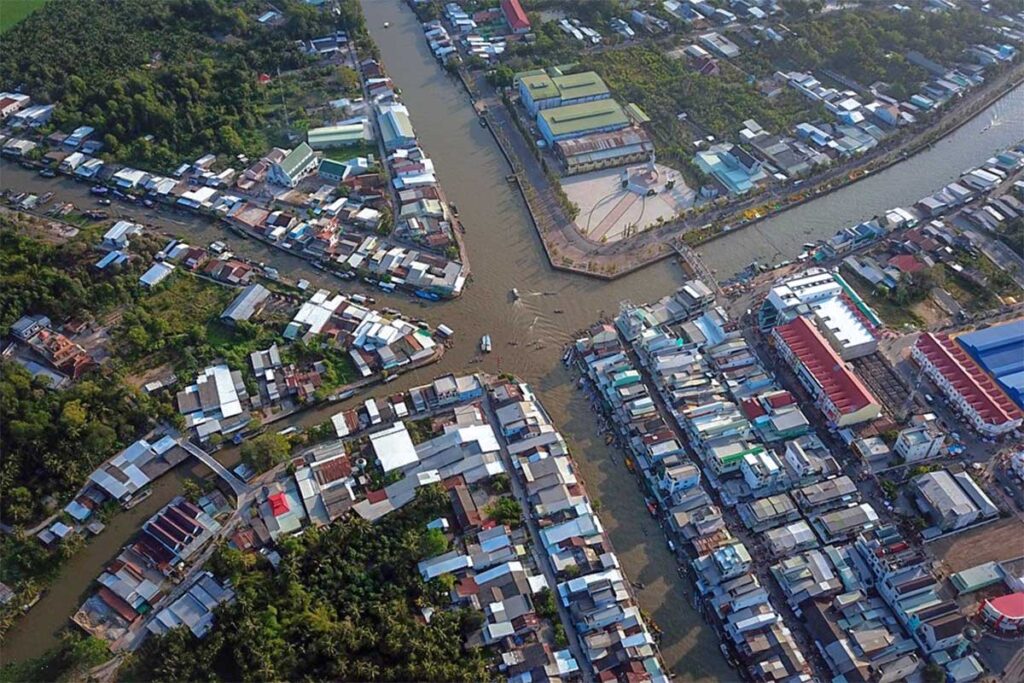
Its strategic location made it a practical stop for farmers and merchants, allowing them to exchange goods without traveling long distances overland. Over time, the crossroads became a thriving market point, supplying surrounding provinces with essential products and linking communities across the delta.
The French canal projects
The floating market’s significance grew further during the late 19th and early 20th centuries, when the French colonial administration carried out extensive canal-digging projects across the Mekong Delta. Major waterways such as the Quan Lộ Phụng Hiệp and Long Mỹ – Phú Lộc canals were constructed to open land for agriculture and improve transport efficiency. These developments expanded Nga Nam’s reach, connecting it more directly with distant provinces and making it easier for traders to bring large volumes of goods to the market. By this time, Nga Nam had become one of the busiest and most important floating markets in southern Vietnam.
Role in daily life
For locals, the floating market was not only about trade but also about sustaining daily life. Farmers and traders arrived with boats filled with rice, fruits, vegetables, and seafood, while others purchased necessities to bring back to their villages. Boats doubled as both means of transport and makeshift stalls, creating a dense network of commerce on the water.
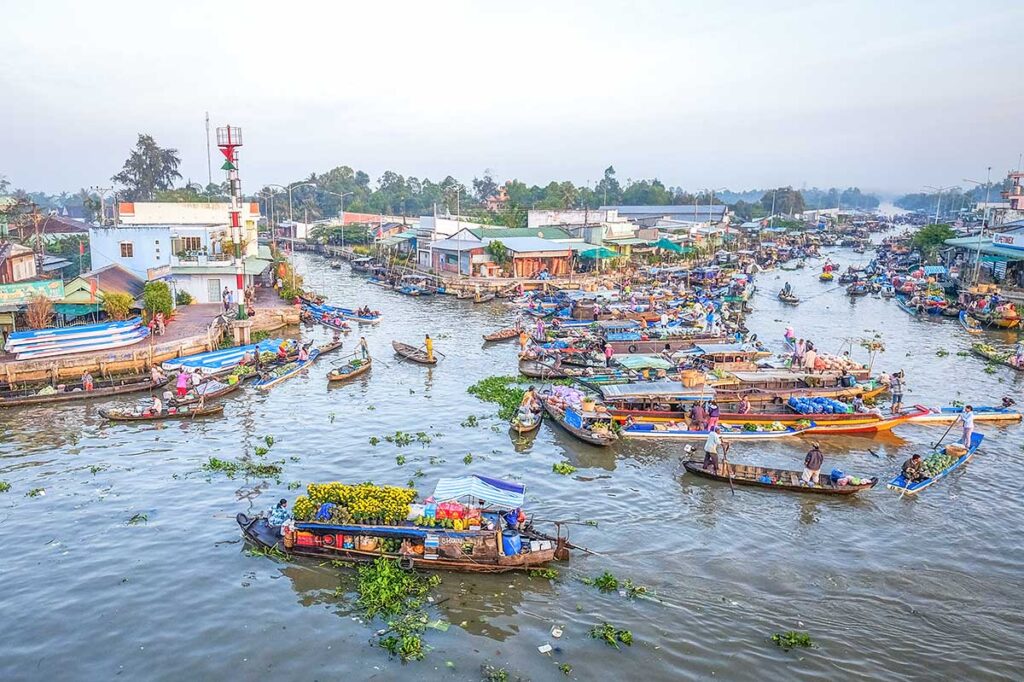
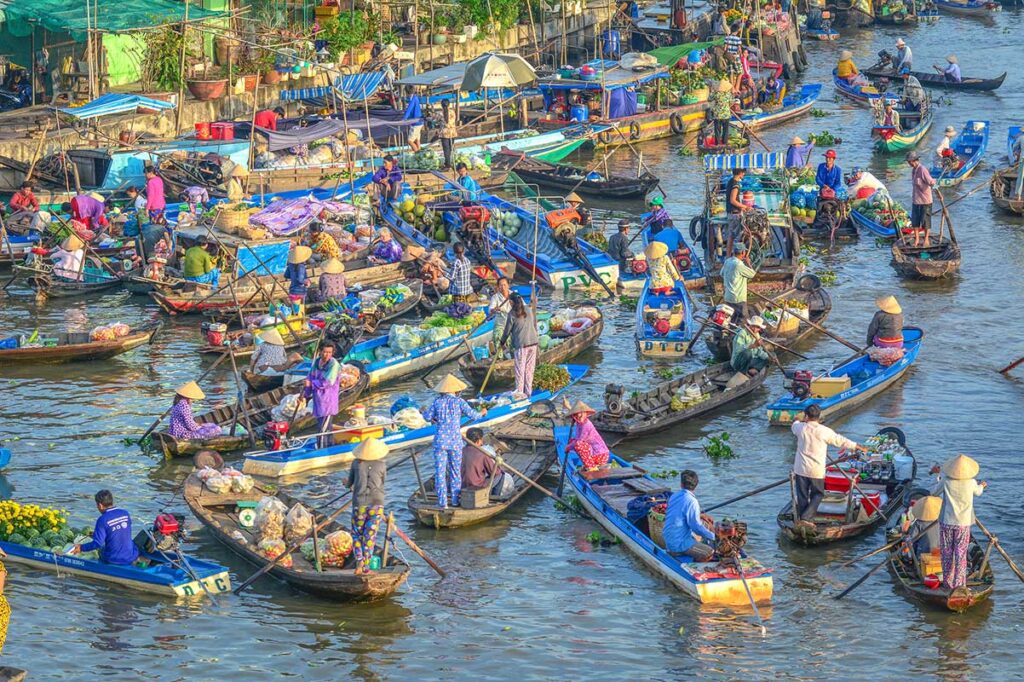
Beyond exchanging goods, the market served as a social center where people shared news, met relatives or neighbors from other provinces, and maintained connections across the delta. In this way, Nga Nam Floating Market became an essential part of the cultural and economic rhythm of the Mekong Delta for generations.
What could you see at Nga Nam Floating Market?
1. Boats and traders
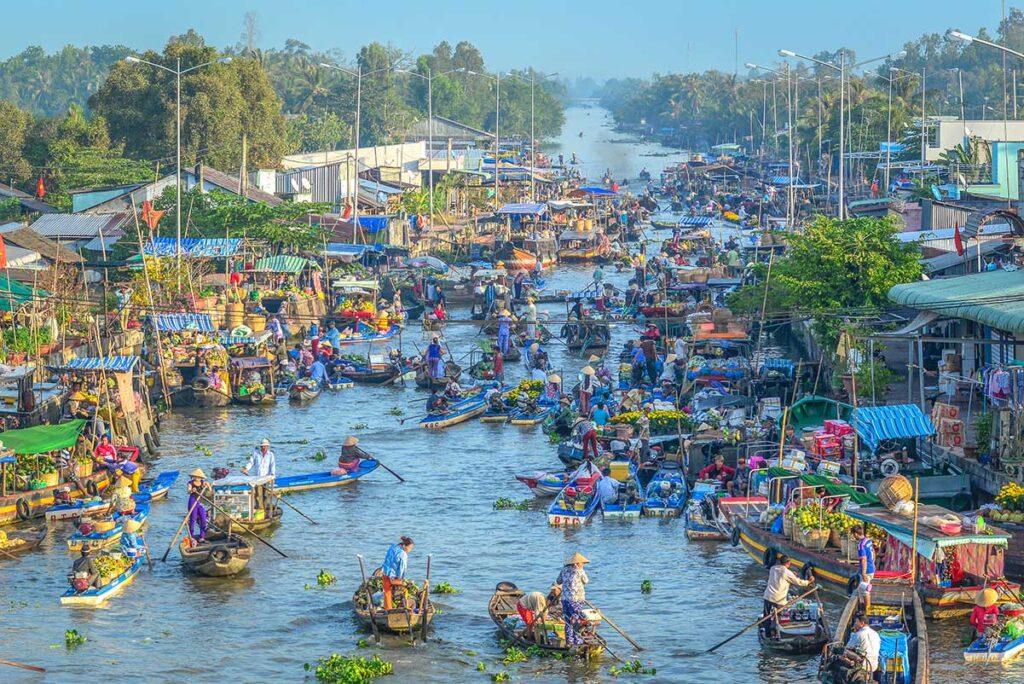
At its peak, Nga Nam Floating Market was a lively mix of large wholesale boats and smaller sampans. The bigger boats carried bulk goods such as rice or fruit for resale, while the smaller ones ferried families selling vegetables, snacks, or household necessities. Vendors used tall bamboo poles, known as cây bẹo, to advertise their products by hanging samples high above the waterline. Traders came not only from Soc Trang but also from Ca Mau, Bac Lieu, Hau Giang, and Can Tho, turning the five-way canal intersection into a crowded waterborne crossroads each morning.
2. Products and Goods
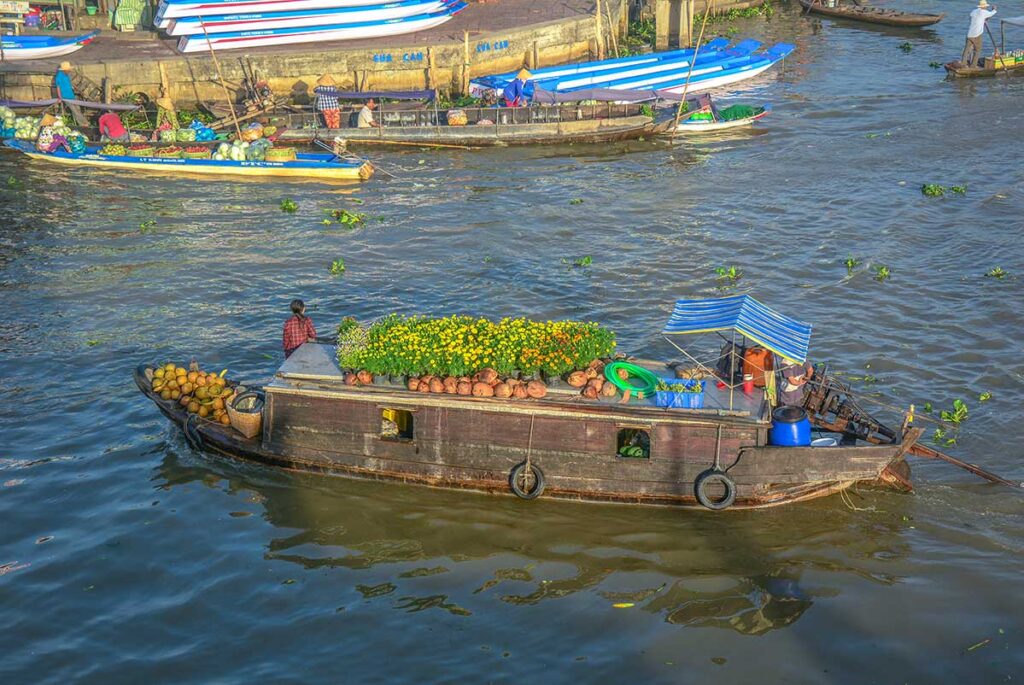
The market reflected the abundance of the Mekong Delta. Boats were loaded with sacks of rice, tropical fruits like mangoes and rambutans, and baskets of vegetables and herbs. Fresh fish, shrimp, and crabs were also common, alongside other daily necessities. Seasonal produce changed the market’s colors and scents throughout the year, giving each visit a slightly different experience. This variety made Nga Nam both a wholesale hub and a practical shopping spot for smaller traders and local households.
3. Food and coffee on the water
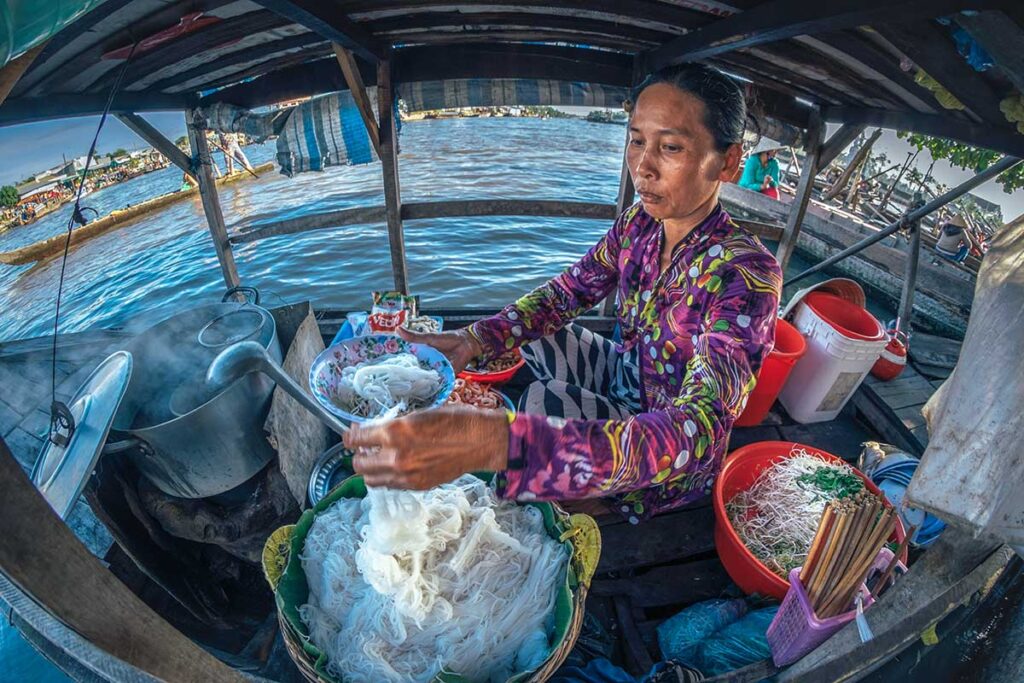
Beyond produce, Nga Nam was also a place to eat and drink. Small floating eateries moved between boats, serving bowls of noodle soup, rice dishes, and snacks to hungry traders and early visitors. Vietnamese coffee, often prepared in metal filters, was sold from simple wooden boats and passed steaming hot to customers on the water. The chance to enjoy breakfast while drifting among dozens of trading boats gave the market a uniquely social and atmospheric feel at dawn.
4. Atmosphere and cultural vibe
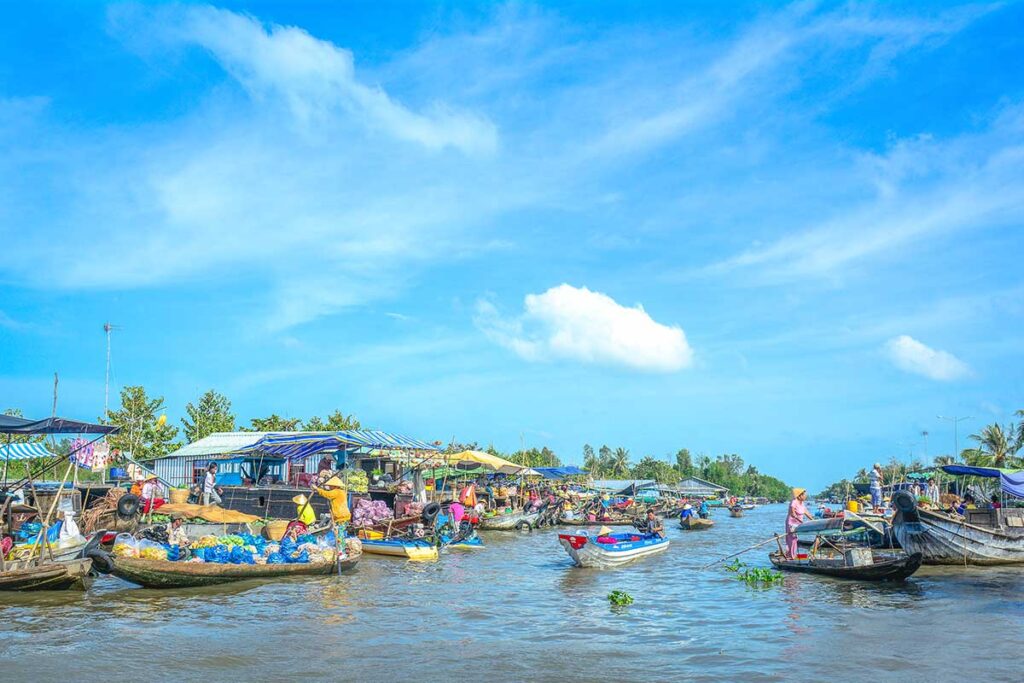
The market was busiest between 3:00 and 6:00 am, when lanterns flickered in the dark, engines hummed, and sellers called out their prices. The constant movement of paddles, motorboats, and chatter created an energy that felt both chaotic and rhythmic. Local culture was also on display: many traders wore the simple áo bà ba outfit of the southern countryside, while their southern accents and occasional folk songs added to the authenticity. More than a place of commerce, Nga Nam Floating Market was a vibrant river community where trade, culture, and daily life all flowed together.
The reality: Nga Nam Floating Market today
Like many floating markets in the Mekong Delta, Nga Nam began to decline as new roads and bridges were built. Once trucks and highways made it faster and cheaper to transport goods overland, trading on the water became less practical. Gradually, fewer boats arrived each morning, and much of the commerce shifted to permanent stalls on shore.
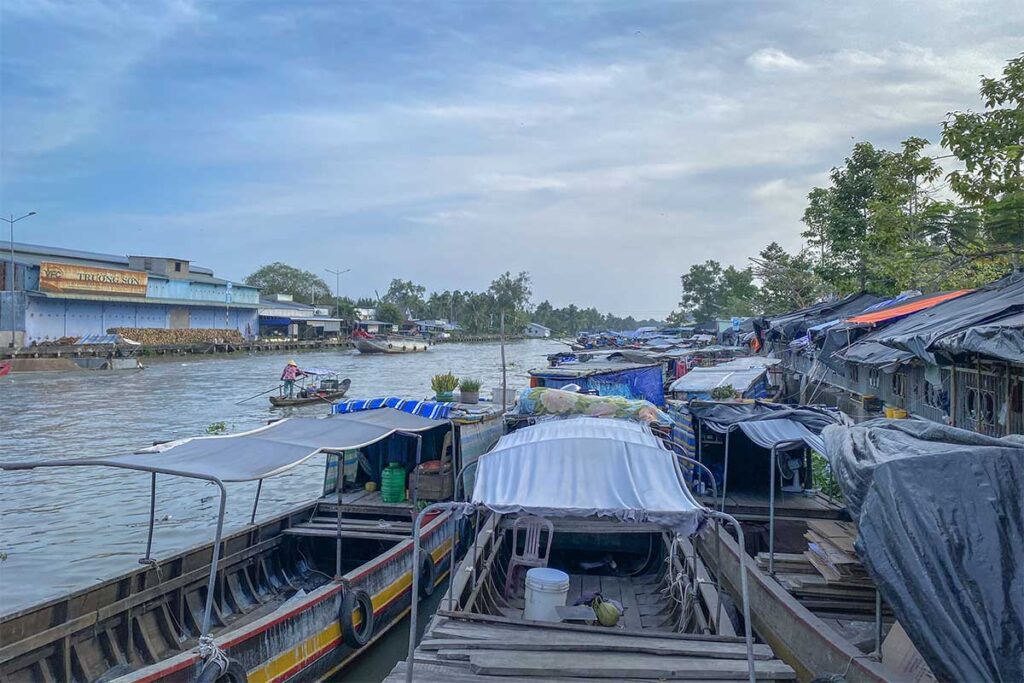
The COVID-19 pandemic delivered the final blow. When restrictions forced the floating market to shut down, traders found alternative ways to sell their produce and supplies, often renting space in land markets or using road transport. Even after the pandemic ended, the boats never fully returned.
Today, Nga Nam still has a lively market, but it is now entirely on land. The crossroads of the five canals remains an important symbol for the town, yet the waterborne trading scene that once defined it has disappeared. Visitors will find a bustling land market and active local life, but not the floating spectacle that made Nga Nam famous.
Highlights of visiting Nga Nam today
The floating market may no longer exist, but Nga Nam still offers several local experiences that make it worth a short stop if you’re exploring this part of Soc Trang Province. From the unique five-way canal junction to rural scenery and cultural landmarks, the town retains a strong Mekong character.
1. Five-way canal junction
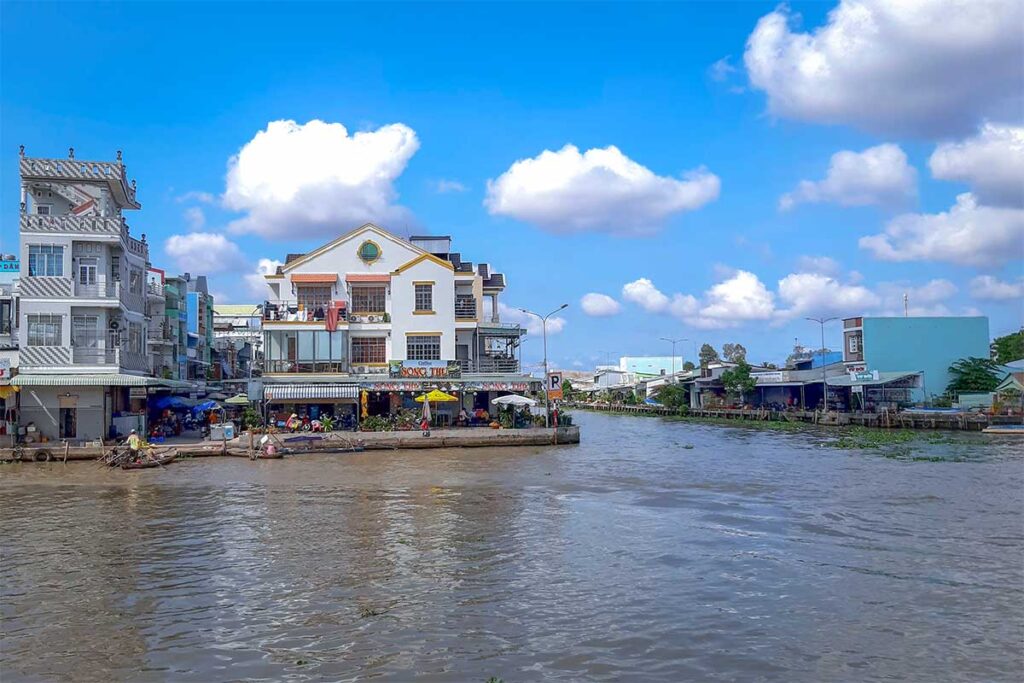
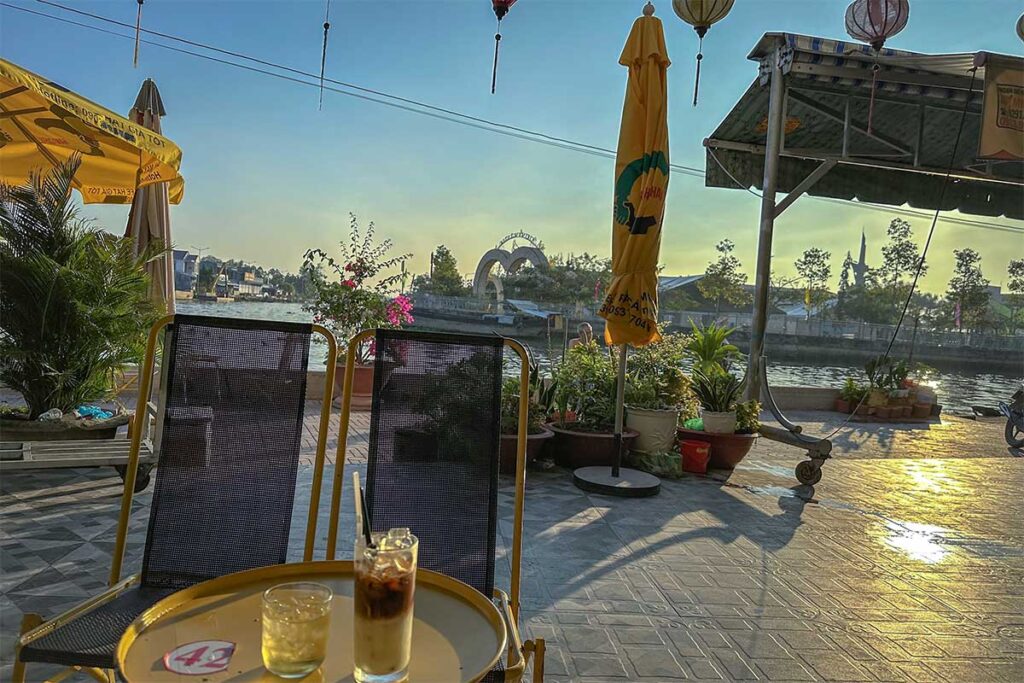
The confluence of five canals is still the heart of Nga Nam and the town’s most distinctive feature. It remains a rare sight in the Mekong Delta, with waterways stretching out in all directions. Even without trading boats, the junction is photogenic and an important symbol of local identity.
2. Nga Nam Land Market
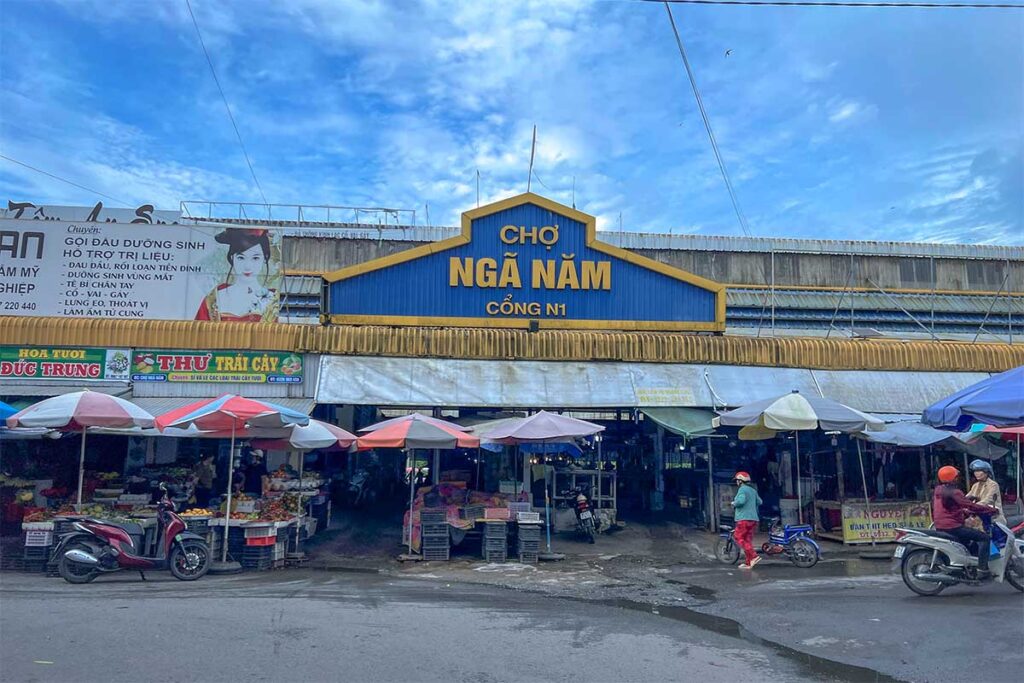
The waterborne trading has shifted to land, but the market is no less lively.
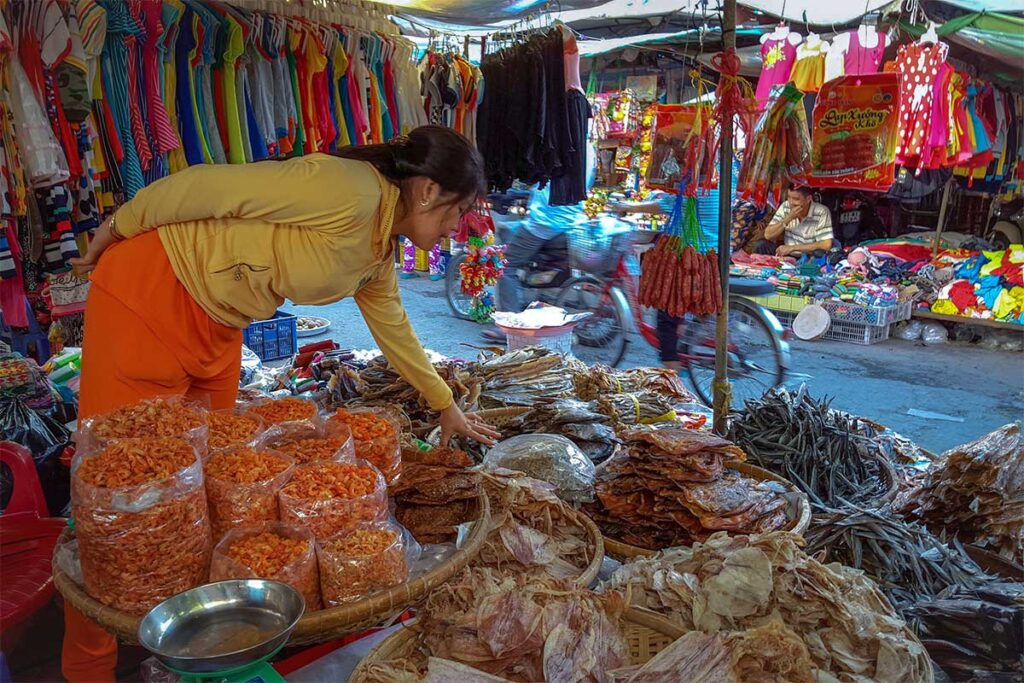
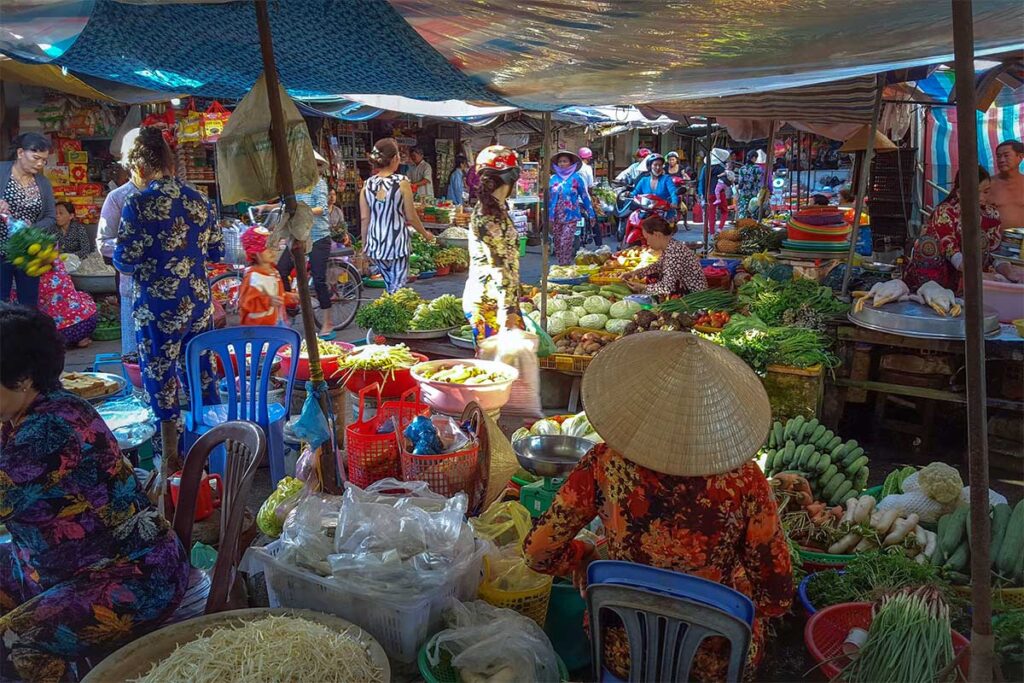
Stalls here sell fresh produce, vegetables, tropical fruits, rice, and household goods, creating the same bustling energy you’d expect in a delta town. It’s a good place to observe daily life and sample regional food.
3. Victory Monument
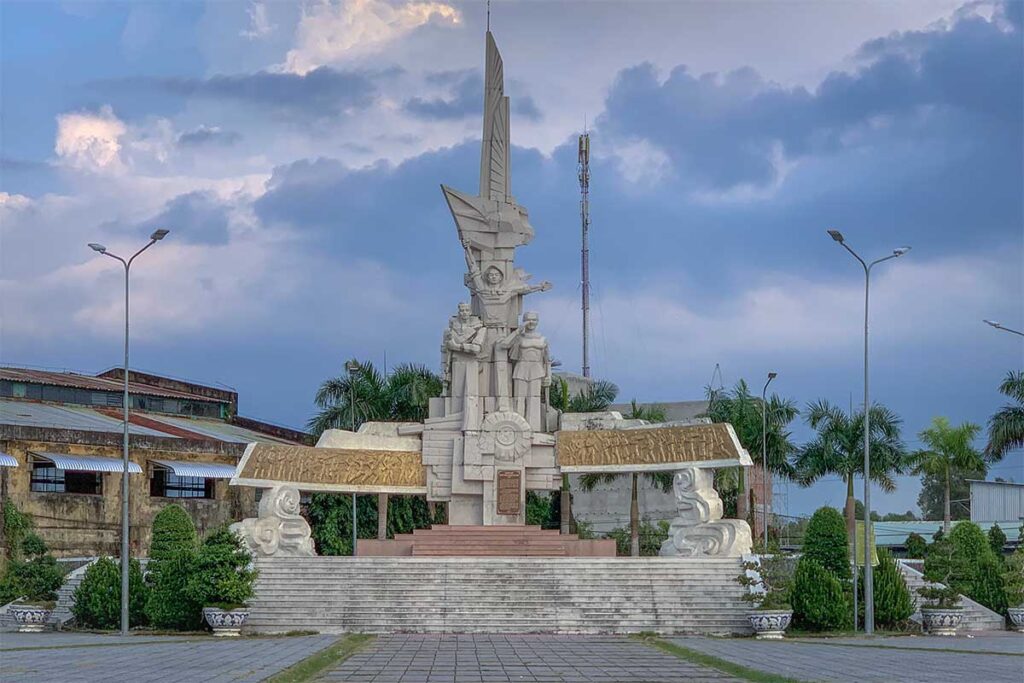
Right by the river intersection stands the Victory Monument, a landmark commemorating local resistance during wartime. While not especially grand in design, it’s a gathering point for the community. In the evenings, the area comes alive with tea stalls, snack vendors, and families enjoying the cool breeze by the water.
4. Local life around the canals
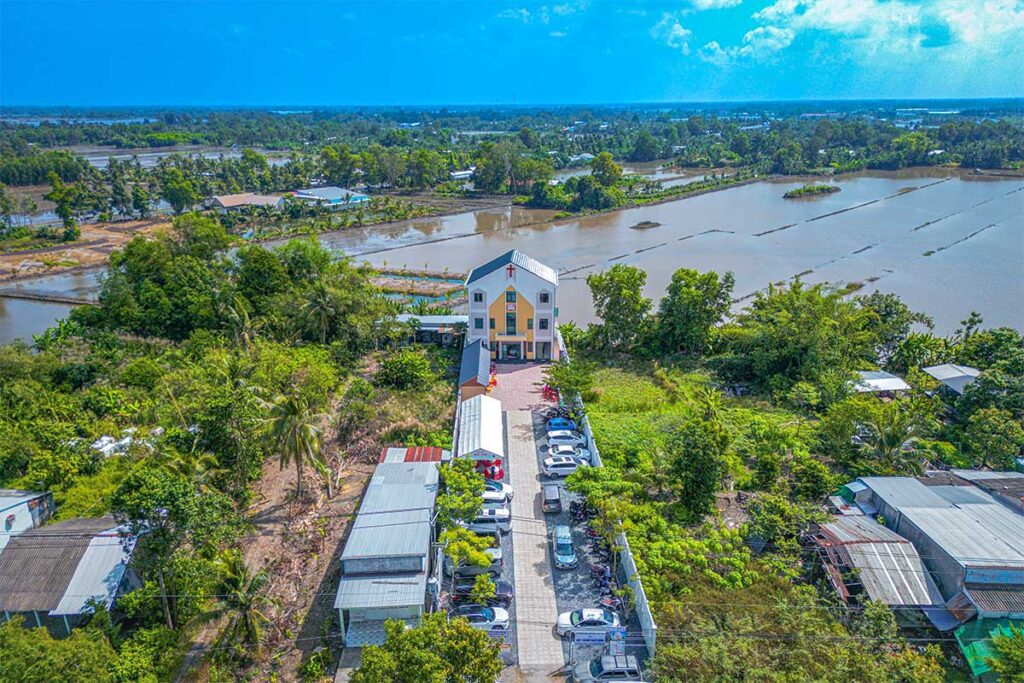
Nga Nam’s rural surroundings remain a highlight. Cycling or walking beyond the center takes you through rice fields, orchards, and quiet canal-side villages. These areas reflect the slower pace of Mekong Delta life and offer a glimpse into the agricultural backbone of the region.
5. Nearby attractions
Nga Nam can also be combined with other sights in Soc Trang Province:
- Tan Long Stork Garden – an eco-site where thousands of storks return to roost each evening.
- O Chum Pagoda – a Khmer temple with traditional architecture, located near Nga Nam.
- Soc Trang’s Khmer pagoda circuit – further afield you can visit Bat Pagoda, Som Rong Pagoda, Kh’leang Pagoda, and Clay Pagoda, all showcasing Khmer heritage unique to the province.
Practical visiting information & Tips
Best time to visit
Nga Nam is no longer a floating market, so timing matters less than it once did. For the liveliest atmosphere, visit in the morning when the land market is active. In the evening, the canal intersection becomes a popular gathering spot, with locals enjoying the breeze and street food.
Facilities
The town has a few essential services, including a gas station and at least two ATMs. You’ll also find plenty of small cafés and eateries, especially around the market and main roads. Don’t expect polished facilities, but everything you need for a short stop is available.
Accommodation
Nga Nam has only a handful of simple guesthouses suitable for an overnight stay. Rooms are basic and aimed at local travelers rather than tourists. If you prefer more comfort, it’s better to base yourself in nearby towns such as Soc Trang, Bac Lieu, or even Can Tho, which offer more reliable hotels and services.
Transport
Nga Nam is well connected by road:
- Soc Trang City – about 60 km away.
- Bac Lieu – about 40 km away.
- Vi Thanh (Hau Giang Province) – about 35 km away.
- Can Tho – about 70–75 km away, depending on the route.
Local buses and shared vans run between these towns, but private car or motorbike is the easiest way to include Nga Nam in a regional trip.
Food & Drinks
Nga Nam has no shortage of local food options. Around the market, you’ll find noodle soups such as bún nước lèo (a Soc Trang specialty), hủ tiếu, and rice dishes. Cafés by the canal serve strong Vietnamese coffee, making them a good place to pause and take in the view. Eating here is inexpensive, authentic, and very much part of the daily rhythm of the town.
Is it worth visiting Nga Nam without the Floating Market?
Nga Nam still holds some appeal, but expectations should be realistic. The five-way canal junction is unique in the Mekong Delta, and the land market offers a genuine slice of local life. If you are already passing through Soc Trang or exploring the province’s Khmer culture, a short stop here can be worthwhile.
However, if your main goal is to experience a floating market, Nga Nam is no longer the place to find it. For most travelers, Nga Nam works best as part of a wider journey—whether combined with Soc Trang’s pagodas, or included on a route toward Bac Lieu, Ca Mau, or Hau Giang. On its own, the town doesn’t justify a long detour or an overnight stay.


